History of Energy Field Research
The interest and research into human energy fields has a long history in Eastern cultures, where health, well-being, medicine, and self-defense are defined in relation to the flow of energy (Judith, 1996). There also has been work done in the West over the past 200 years with different investigations and practices (Brennan, 1987). More recently, such concepts are incorporated into research and practice within Western medicine and views of health (Gerber, 1988; Shealy & Myss, 1993).
The work on human energy fields has included interest in energy around the body (the aura), energy running through channels within the body (the meridians, used in acupuncture), or around the chakras, a type of energy transformer from more subtle to more dense energies or the reverse. Yet most of the research that has been conducted has focused on adults. Very little systematic research has been done on children, with the exception of the observational work by Leigh, Metzker, & Hilton (1997). In addition, recent developments of instruments that measure energies have helped increase the ability to do better comparison work.
The current research compared the energy fields of four different groups of people. The interest was to see if there were differences in the energy fields for these groups, especially looking at children compared to adults. In addition, two separate groups of adults also were compared to see if those that work with energy had any different fields from those who tend not to do such work.
Procedures for the Work
The participants were children, adolescents, and adults from the general population. All were volunteers who were part of a program evaluation or were interested in the results of the energy assessment. The people were divided into groups based on age and experience with energy. There was a group of eight children (group #1 on the graphs) ages 2-12 who were part of an earlier evaluation. The second group (group #2) was composed of 16 adolescents ages 13-19 who were part of a different program evaluation. In each case, a parent gave permission for the assessment. The third group (group #3) was 16 randomly selected adults, ages 21-54, out of a larger group who had requested that an assessment be done. A fourth group (group #4) of adults, ages 20-46, volunteered to have assessments completed. These adults were masters of a Korean practice called Dahn Hak and frequently do exercises to open the energy flow and use energy with others almost every day (Lee, 1999, 2002).
The assessment of each energy field was done using the Gas Discharge Visualization (GDV) technique. This machine currently is available and being used by researchers and clinicians in many different countries (Korotkov, 1999), including for health assessments in Russia. This machine takes a computerized photograph of the energy around each finger of the hands, which then can be analyzed and compared with others. This provides a more precise measure than simple observations of fields that have been used in the past (Leigh et al., 1997).
From the many available parameters in the photograph, 13 key aspects of the field and measures of the seven chakras were included in the analysis. Gender of the participant also was used to see if there were any differences that might be important. The definitions for each of the 13 parameters are identified briefly:
- Aura – The total area of GDV- aura.
- Symmetry – the balance between the area of the aura on the left and the right side of the body.
- Area normalized – GDV-gram area relative to the inner oval of the picture.
- BEa – area of removed “noise,” or those things that seem random, in pixels.
- Average brightness (I??)– average from 0 to 255.
- Spectrum width – width of spectrum from 0 to 255
- Density total –density for the whole GDV-gram.
- Form coefficient – reflects the edge of the GDV- gram outer contour.
- Fractal dimension – fractal coefficient, reflecting the GDV-gram outer contour. Less sensitive to the GDV-gram form changes.
- Entropy of brightness – the overall measure of general health of the field in terms of its brightness.
- Entropy of geometry – the overall measure of general health of the field in terms of its geometrical shape.
- Fractical brightness – another measure of the brightness of the field based on fracticals.
- Fractical geometry – a measure of the shape of the field based on fracticals.
What Was Found?
Using a statistical measure to compare averages for each group, seven significant differences were found. Of the 13 parameters included plus gender, these seven differences included the area of the aura, the area normalized, the form coefficient, the entropy of brightness, the entropy of geometry, fractal brightness, and fractal geometry. The other parameters and gender had no significant differences.
In terms of the area of the aura, the greatest area occurred with the Dahn Masters. They seemed to have the strongest and largest auras as a group, followed by adults and adolescents, with children having the smallest, consistent with previous research. This can be seen in the graph below.
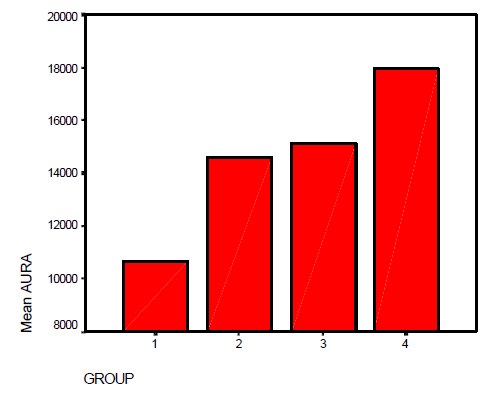
Mean data of AURA
On the other hand, when the area is normalized, the outcome looks quite different. Here, the children have the largest fields, and the Dahn Masters and adolescents are similar, as seen in the graph below. In this way, what is first seen with children’s fields as being smaller may not be as accurate when looking at the essence of the field rather than the rough indicators of fields. This is similar to the results found by Leigh et al. (1997), with some questions about how we have interpreted the previous observations of children’s fields.
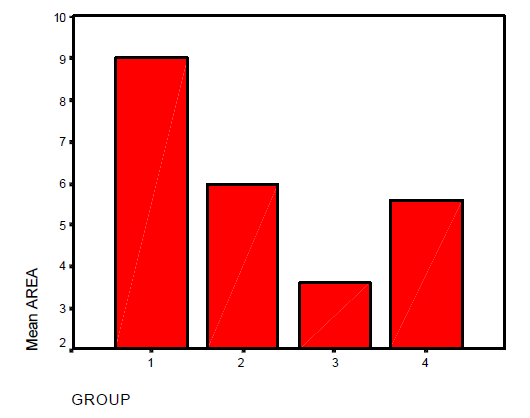
Mean data of AREA
With the measures of general health in terms of brightness and geometry, the children were quite unique from other groups (next 2 graphs). The Dahn Masters were second and adolescents lowest, although the differences here were not nearly as great. In this way, there is some concern about what is going on with adolescents and again presents a different view of children.
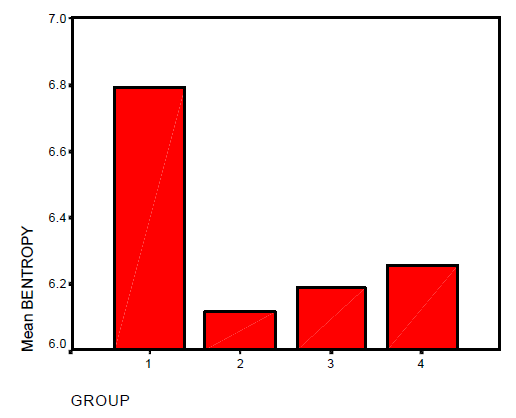
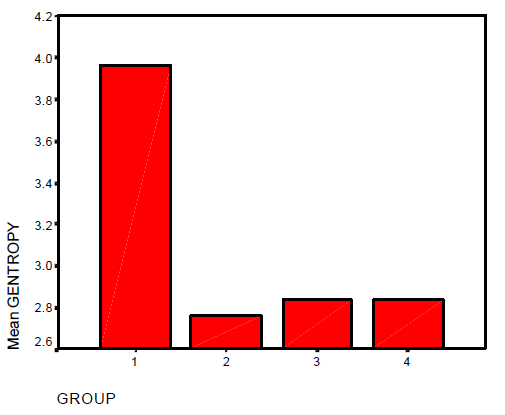
Mean data of GENTROPY & BENTROPY
With the comparison of the seven Chakras, the regular adult group had the least open chakras, while the Dahn Masters again looking more like the adolescents, as is seen with the graph of the third Chakra. Clearly, children had the most open Chakra, and the adults were most closed.

Mean data of THIRD
As with some of the parameters, Dahn Masters also appeared similar to the children, as with the second Charka in the graph below.
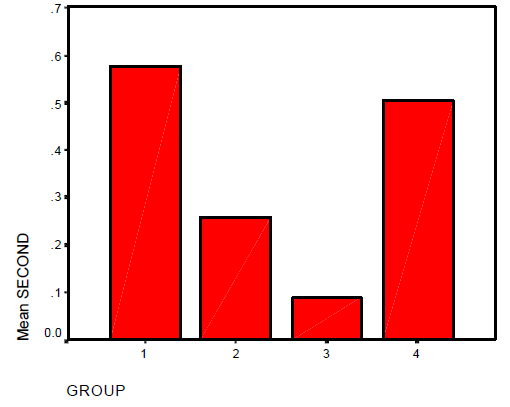
Mean data of SECOND
What Do The Results Mean?
The results present a very different picture that what would be expected from a typical perspective of child to adult development. Rather than the two adult groups being similar, the Dahn Masters frequently were like the energy fields of adolescents and children. While the Dahn Masters were similar in age to the regular adult group and began their practice as adults, it is unlikely that their fields simply remained as children and adolescents. Rather, it is likely that the fields changed through their practice. In this way, energy fields do not seem to have inevitable outcomes, but seem to be influenced by what people do.
The results of this work would support the concept that practices designed to maintain the health of the fields may be important in the lives of individuals. On the other hand, such practices probably do not occur with minimal work, but through sustained efforts. The Dahn Masters in this study had been practicing for many years and are considered adva nced masters. Such changes probably do not come quickly or with minimal involvement.
The findings provide interesting support of differences in energy fields for children compared to adolescents and adults. In addition, the differences in the two adult groups would support the idea that changes in human energy fields may have more to do with what we do and how we live rather than inevitable changes over a life span. It
will be important to follow the same individuals over a long period of time to verify these results. But until such work can be completed, these results provide some useful information about human energy fields in different part of the life span.
One of the implications of this work is the importance of people to keep the energy fields open. This most likely can be done in many ways, although only one method was tested here. People doing stretching exercises, like with Dahn Hak, yoga, tai chi, chi qong, or other similar practices, most likely would see a difference in their energy fields. In addition, working at stress reduction and relaxation techniques most likely would find less contracted energies both around and within the body. Finally, working with energy focusing or similar meditative techniques not only would be more relaxed, but also would be more sensitive to what is happening to their energy fields and help with energy flow.
References
- Becker, R. O., & Selden, G. (1985). The Body electric. New York: William Morrow & Co.
- Brennan, B. A. (1987). Hands of light. New York: Bantam Books.
- Gerber, R. (1988). Vibrational medicine. Sante Fe, NM: Bear & Company.
- Judith, A. (1996). Eastern body, Western mind: Psychology and the chakra system. Berkeley, CA: Celestial Arts.
- Berkeley, CA: Celestial Arts. Korotkov, K. (1999). Aura and consciousness. St. Petersburg, Russia: Russian Ministry of Culture.
- Lee, Seung-Heun (1999). The way to perfect health. Seoul: Dahn Publications.
- Lee, Ilchi. (2002). Brain respiration. Las Vegas, NV: Healing Society.
- Leigh, G. K., Metzker, J. A., & Hilton, J. M. (1997). An observational study of human energy fields in infants and young children. Subtle Energies and Energy Medicine, 8, 213-241.
- Shealy, C. Norman, & Myss, Caroline M. (1993). The creation of health. Walpole, NH: Stillpoint.
Mean AURA
| Group |
Mean |
| 1 |
10500 |
| 2 |
14500 |
| 3 |
15000 |
| 4 |
18000 |
Mean AREA
| Group |
Mean |
| 1 |
9 |
| 2 |
6 |
| 3 |
3.5 |
| 4 |
5.5 |
Mean BENTROPY
| Group |
Mean |
| 1 |
6.8 |
| 2 |
6.1 |
| 3 |
6.2 |
| 4 |
6.25 |
Mean GENTROPY
| Group |
Mean |
| 1 |
3.95 |
| 2 |
2.75 |
| 3 |
2.85 |
| 4 |
2.85 |
Mean THIRD
| Group |
Mean |
| 1 |
0.57 |
| 2 |
0.28 |
| 3 |
0.01 |
| 4 |
0.28 |
Mean SECOND
| Group |
Mean |
| 1 |
0.68 |
| 2 |
0.25 |
| 3 |
0.18 |
| 4 |
0.51 |
Leigh, G., Leigh, C., and Polonko, K.
2003,
Differences in Human Energy Fields,
Extension | University of Nevada, Reno, FS-03-68


